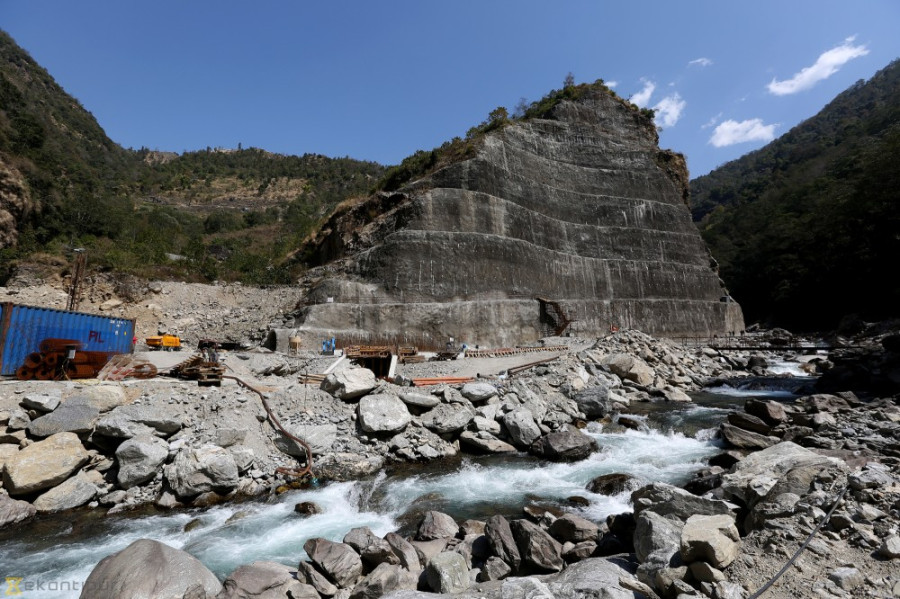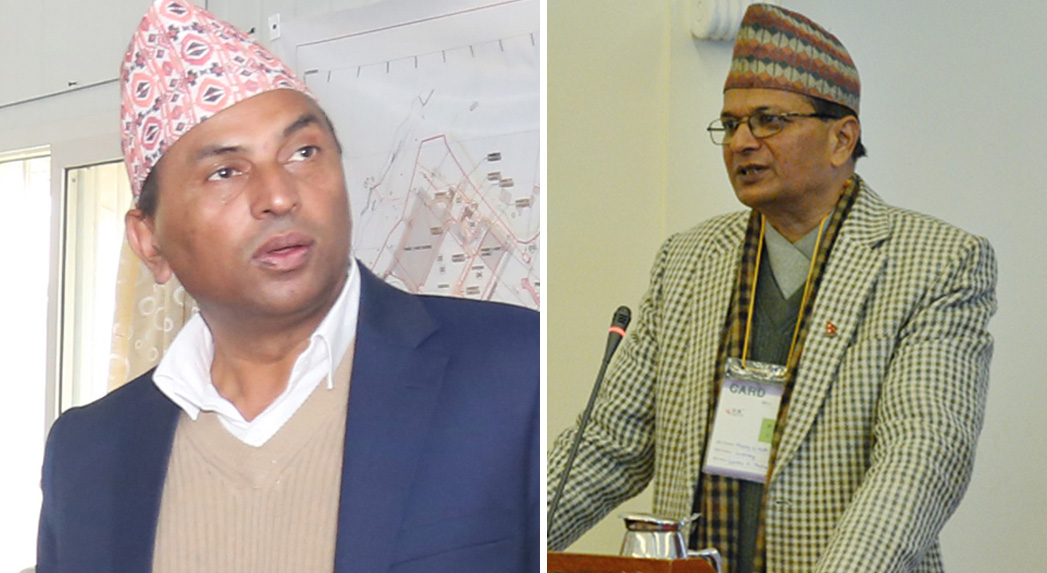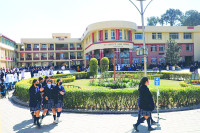Valley
Nepali bureaucrats regularly asked for ‘their cut’ from Melamchi contractor, Italian officials say
Rampant corruption, regular demands for commission by government officials, and labyrinthine bureaucratic hassles forced the Italian contractor to abandon the Melamchi Water Supply Project, throwing the national pride project that is close to completion into uncertainty once again, a Post investigation has revealed.
Chandan Kumar Mandal
Rampant corruption, regular demands for commission by government officials, and labyrinthine bureaucratic hassles forced the Italian contractor to abandon the Melamchi Water Supply Project, throwing the national pride project that is close to completion into uncertainty once again, a Post investigation has revealed.
A series of interviews over the last two months with several officials, including senior members of the Italy-based Cooperativa Muratori e Cementisti di Ravenna (CMC) and the government of Nepal, show that negotiations between the two sides were marred for months by ambiguities before the termination of the contract in February. But two Italian officials who spoke to the Post went beyond, and said Nepali government officials sought commissions on a regular basis during their last three years working on the project.
The latest dispute between the Nepal government and the Italians flared up after the government refused to pay Rs 362 million—decided by the Dispute Adjudication Board in October last year—to the contractor for the additional work it did at the site after the 2015 earthquake. According to two top CMC officials, both of whom spoke on condition of anonymity because they weren’t authorised by their headquarters to speak with the media, the same government officials who asked for commissions with the contractor were the ones actively involved in blocking the payment recommended by the independent third-party committee.
Both Italian officials named two senior Nepali bureaucrats—Gajendra Kumar Thakur, a former secretary at the Water Supply Ministry, and Surya Raj Kadel, executive director of the Melamchi Water Supply Development Board—as the officials who demanded a cut in the amount approved by the Dispute Adjudication Board.
“Thakur and Kadel told the CMC manager for the Melamchi project that they wanted a discount of Rs 62 million on the payment and a cut of 3 percent on the remaining Rs 300 million,” said the CMC official in an interview over the phone from Ravenna, Italy.
Both Thakur and Kadel denied the allegations in an interview with the Post.
“I won’t listen to you. This is wrong. Who told you all this? Who told you about the 3 percent cut?” Thakur told the Post reporter, screaming over the phone before hanging up.
Thakur, who was at the Water Supply Ministry for the past year, was transferred to the Office of the Nepal Trust last month. While he denied asking for a cut, he said that the board’s executive director—Kadel—might have asked for the discount.
Kadel, too, denied charges that he had asked for a commission but admitted that he had asked for a discount in the payment as per the overhead cost deduction—as instructed by the adjudication board. According to Kadel, the discounted amount would total nearly Rs 25 million.
“The money from the discount would not have been ours to keep—that would have gone directly to the government,” Kadel said. “The calculations had yet to be done, but that’s when CMC had its own management issues and they were looking for an excuse to abandon the project.”
Italian officials disagree with Kadel, and say government officials were not entitled to the deduction.
The second CMC official who spoke to the Post, and held a top position overseeing the Melamchi project in Nepal, said government officials had always been involved in seeking a commission from the contractor.
“Usually the cut was paid to the executive directors of the Melamchi board and was negotiated in meetings with Project Director Giuseppe Di Giorgio,” the CMC official said in a phone interview. “I know and can confirm that they wanted a discount and a cut from that payment. Usually their demand was 2 to 3 percent of the amount involved.”
“Sometimes they would ask for four percent cut, according to Di Giorgio, but obviously he had his own cut, too,” the official told the Post.
The Italian group fired Di Giorgio in August 2018 because of his involvement in personal financial negotiations with government officials.
The Melamchi Water Supply Project, which was launched in 2000 after decades of conceptualisation, has long been seen as the sustainable solution to Kathmandu’s chronic shortage of drinking water. In the first phase of the project, the government plans to divert about 170 million litres of fresh water per day from the Melamchi River in Sindhupalchok district to the three cities of the Valley.
But the project has long been embroiled in controversy because of corruption, political backpedaling and bureaucratic inadequacy. Last year, the government promised Kathmandu residents that water from Melamchi would arrive by the Dashain holidays, just before fresh disputes arose between the government and the contractor.
The government had roped in the Italian company in 2013 after terminating the previous contract with China Railway 15 Bureau Group, following the latter’s sluggish progress in tunnel and headwork construction. After signing a Rs 7.72 billion deal with the government that year, the Italian contractor started work at Sundarijal in January 2014.

How the controversy began
Following the 2015 earthquake, the Italian contractor had to perform additional work—beyond what was stipulated in the original contract—at the Melamchi site. When the work was done, it billed the government for Rs 1.56 billion on top of the deal it had originally signed in 2014.
CMC officials said that in the beginning, the government did not even agree that the work performed after the earthquake was “additional work”, as per the terms of the contract. “This issue was then taken to the adjudication board, which, in June 2016, agreed that the additional work was a variation. Since the cost and additional time had not been calculated beforehand, the government should be billed immediately after the work was done,” the Ravenna-based CMC official told the Post.
Here’s how the Italian group calculated Rs 1.56 billion for the additional work: a direct cost of Rs 476 million for construction material and labour equipment, and Rs 974 million in indirect costs, for daily operations, salaries, bank guarantee interest, and electricity, among others. The indirect cost was calculated at Rs 1.7 million per day prolongation cost, as the amount decided by the dispute adjudication board for 570 days—the length of time CMC said it took to finish the work.
In 2017, the government released a partial payment of Rs 253 million out of the total direct cost. The CMC had also demanded Rs 13 million for road construction work—also part of the total Rs 1.56 billion—which was paid in September the same year.
However, the lump sum bill CMC submitted to the government also included Rs 190 million, the amount requested by government officials as their commission. However, the CMC official said the cost had to be hidden under the category “loss in efficiency” because they couldn’t use “cut for the employer” in an official bill.
“The bill was padded with the additional Rs 190 million because the persons in charge from the government side requested that the CMC management at the time—Giuseppe Di Giorgio and Salvatore Casciaro—to add this amount, so that the government officials could take their cut and release the amount requested by CMC,” the official for the Italian contractor told the Post.
As the dispute over the total amount owed by the government for additional work could not be settled between the Nepal government and the Italian contractor, the issue was forwarded once again to the adjudication board—an independent body with three individuals agreed upon and appointed by the both employer and the contractor—in March 2018.
Seven months later, the board ruled in favour of the Italian builder, saying the government should pay the contractor Rs 362 million. The board, however, also said the CMC should only be compensated for 233 days, against its initial claim of having worked for 570 days.
“We had hoped that the government would also release the remaining Rs 213 million as well as the amount decided by the board,” the official told the Post. In a letter dated October 26, 2018, the adjudication board said that the sum was to be paid within 21 days of the receipt of the decision.
However, the payment never happened, and the Italian builder handed in a two-week termination notice on November 30 last year as a final warning to the government. When the money was still not released, CMC terminated its contract on December 17, 2018, after repeated reminders on the 5th, 17th, and 30th of November, according to the CMC official.
Two days ahead of the termination notice deadline, on December 15, Kadel, the executive director of the project, called a board meeting to decide whether the payment should be released to CMC. But the meeting never took place as Thakur, the ministry secretary, never showed up.
In the government ministry, as well as among Nepali officials working for the project, there was a widely prevalent fear that if the payment was released in full to the Italians, they’d flee without paying the local subcontractors. Government officials also told the Post that the adjudication board could not dictate the deadline at a time when the government itself was planning to file its own Notice of Dissatisfaction against the board’s decision.
“Just because the board decided on the amount does not mean we would have to pay them,” Kadel said. “We had decided to challenge the decision and file our notice of dissatisfaction.”
While local subcontractors have been demanding that CMC pay their dues, they have also been critical of the government for not paying the amount that the adjudication board recommended. In a statement released last month, a group of local contractors and suppliers said the government should have first cleared the dues before issuing a Notice of Dissatisfaction.
Thakur, who during the interview with the Post said that CMC could not be paid because the government had filed the notice, contradicted his own statement and said that the government was ready to pay them.
“We were ready to pay them but CMC would take the money back to its headquarters in Italy. We wanted them to spend the money here and clear dues of local vendors first,” said Thakur.
CMC officials said it was standard practice to have a rolling payment for local subcontractors, and that it was the government’s hesitation in releasing the regular payments that delayed payments to subcontractors.
“This situation was magnified because the government never paid CMC its full monthly amount,” the CMC official in Ravenna said. “Furthermore, they were asking for a cut from the monthly wages as well.”
Kadel strictly denied claims that the government was holding back monthly payments. “I have cleared their amount as soon as it was approved by engineers,” he said.
But CMC officials said problems with monthly payments regularly affected work, regardless of which government official was in charge of the project.
“There was an agreement that monthly payments would be released quickly in order to ensure progress, and in return, we would pay them a minimum of one percent every month,” said the CMC official. Each of these monthly commissions ranged between Rs 2 to 3 million.
Thakur, in defending himself, pointed fingers at other government officials, whom he said were involved in colluding to pay hundreds of millions to the Italian contractor anytime there was a controversy over payments.
“Consultants, executive directors of the board, other government officials, legal officers and local agents would then split the commission,” Thakur told the Post.
But former officials, some of whom were accused of being embroiled in corruption by the Italians, lashed out at Thakur for turning his allegations against them.
“Secretary Thakur has tried to cover up his own misdeeds and incompetence by blaming other government officials. He has also said so many things in the media which have no basis in fact,” said Ramchandra Devkota, who retired from civil service last year after a 14-month tenure at the Melamchi project.
Devkota said that whatever progress the project has made, was because of the significant work done under his leadership. “The breakthrough in tunnel digging was achieved when I was in office. The progress has reached a point from where now even local contractors can complete the project,” Devkota said.
During interviews with CMC officials, it was clear that the demands by government officials for commission had begun long before the latest fiasco involving Thakur and Kadel. “They [government officials] were involved in asking for a cut as soon as they assumed office. Be it Mr Devkota, or Mr Bhattarai before him,” said the CMC official.
Ghanshyam Bhattarai, who served as executive director of the Melamchi project for five years, had retired from the civil service in April 2017. He too denied that he was involved in demanding a commission from CMC. “I was always strict about completing the work by following contractual terms and conditions, and CMC always tried to weaken me so they could work on their own schedule,” Bhattarai told the Post in a phone interview.
“Why were they silent for all these years?” he said. “They could have terminated the contract at any time.”

Meet the middle man
The two Italian officials who spoke to the Post said almost all, if not all, backdoor negotiations for commissions and cuts took place through Dinesh Shrestha, the primary subcontractor associated with Cooperativa Muratori e Cementisti di Ravenna.
According to the CMC official, who is familiar with the company’s finances tied to Melamchi, payments to government officials would also go via Shrestha, whose companies had been supplying construction materials, along with vehicles and equipment, to CMC via his companies Bira Motors and Bira Furniture.
According to the second CMC official, Shrestha’s other company—Suresh General Wood and Construction—was used for the sale of construction materials while Bira Motors was for renting and maintaining vehicles for CMC, EPTISA and the Melamchi board.
Bira Furniture, according to the official, provided services for the construction of the site camp and the supply of furniture and house appliances. The company also supplied cement and reinforcement steel. Lately, Shrestha’s Bira Motors has also been renting out construction equipment like excavators, trucks and compressors.
Both CMC officials said the cut meant for government officials would be included in the payment for services provided by Shrestha’s companies.
“Payments for officials would be made in cash using services and invoices issued by Dinesh Shrestha’s group of companies,” the CMC official who had closely overseen financial transactions told the Post. “Only Dinesh Shrestha could acknowledge that no materials were delivered but that will put him in a difficult position with the tax office.”
When the Post asked Shrestha about his involvement as an unofficial agent between the Italian contractor and the government officials, he said he was only a “supplier” involved in supplying construction materials.
“I am not the agent who works for the commission. But I did try to facilitate negotiations between both parties whenever there was any dispute. These are things from the past. I don’t remember the details,” Shrestha told the Post. “They might have done such negotiations themselves. I don’t know anything else.”
It was not only Shrestha’s services through which such illegal payments were made to government officials. Two transport companies that were providing services to CMC—SR Transport and RS Dhuwani Sewa—were also involved in padding up commissions by framing those as transportation expenses.
“In some instances, we used transport companies that would issue us transportation invoices. From that payment, a certain amount would go to those officials,” the CMC official said.
CMC officials also said it was Shrestha who encouraged government officials, led by Thakur, in apprehending the Italian group’s staffers in December and seizing their passports.
Last year, in December, the government barred eight members of the Italian contractor from leaving the country, accusing them of trying to flee without completing the project. However, the Italians contradicted the government claims and said that they were only flying to their home countries to celebrate Christmas and the New Year.
The blacklisting of Italians at immigration and the seizing of their passports caused diplomatic friction, leading the Italian Embassy in New Delhi to intervene and force the government to hand back the passports to the contractors.
“After the fiasco, CMC staff and executives lost confidence in the government’s goodwill towards them and the chances of returning to complete the project became slimmer,” the CMC official said.
Shrestha said he wasn’t involved in decision to seize the passports, but he had asked the government that the dues of local subcontractors should be recovered before Italians left the country.
Troubles abroad—and dilemma in Nepal
In recent months, the Italian contractor’s troubles have appeared elsewhere. Last month, newspapers in Kenya reported that CMC had left three of the country’s megaprojects in limbo.
According to the Standard, CMC abandoned hydropower and drinking water projects in two counties in Kenya even after receiving a down payment. The newspaper also said CMC was involved in bribing top Kenyan government officials to win bids for lucrative projects.
But in Nepal, CMC officials said they couldn’t continue work if they refused to pay government officials. When asked why CMC would pay Nepali government officials huge sums in commission, the senior Italian official said that it was because the company itself was also facing a financial crisis.
Cooperativa Muratori e Cementisti di Ravenna is the fourth largest Italian construction company by revenue, with consolidated revenues of approximately 1.2 billion euros in 2017. But last year, the company was downgraded to B3 from B2 and its probability of default rating to B3-PD from B2-PD by the Moody’s Investors Service, changing its outlook on all ratings from stable to negative. The CMC, which has a solid presence in transport, infrastructure, water and irrigation sectors in countries around the globe, had admitted in November in a press release that it was on the brink of bankruptcy.
“At the time, cash flow was a big problem and any delays in payment would have impacted the progress of works. So it was in mutual interest that CMC would pay those shares requested by government officials,” the CMC official told the Post.
According to the official, the cash flow was also significantly low since there was no financial support from the head office from 2016 onwards.
“If there had been a positive cash flow in Nepal, CMC would have continued in the country,” the official said. “However, the government’s reluctance to pay dues created a difficult situation for CMC at a time when it was in need of liquid funds.”
The CMC official, who said the Italian group wanted to enter the Nepali market to tap the hydropower sector after successfully completing Melamchi, recalls how their experience in Nepal turned unpleasant.
“We had no intention of not completing Melamchi,” the official said. “The intent was always to complete that project and to start Tanahu Hydropower, and to continue to bid for other projects.”
But in addition to demanding commissions, Italians said they regularly faced bureaucratic hassles—like renewal of their work visas—much of which they said appeared to be an intimidation tactic by government officials.
“Kadel would often delay recommendations for visa renewal and gestures like that made the environment hostile and it was very unpleasant to work,” the Ravenna-based CMC official said. The other Italian official concurred.
“The immediate government officials handling the Melamchi Project have always been giving trouble to CMC members,” he said.
But Kadel defended himself once again, and said not a single CMC official had to stay in the country without a renewed visa for a single day.
“There were 29 workers and all their visas were renewed on time. I had appointed a separate staff member to overseeing their visa issues, as I was afraid that working under an expired visa could create problems. At times, I personally visited the immigration office to facilitate their visas,” said Kadel, who blamed the Italians of complaining “now that they have left the country.”
When CMC officials did not return after their Christmas and New Year holidays, the government finally terminated its contract last month.
But despite the formal termination of the contract, some government officials have attempted to bring the Italians back to complete the project. Earlier this month, a special team was dispatched by Bina Magar, Minister of Water Supply, to hold talks with CMC officials in Singapore.
In response, CMC sent back a list of demands as preconditions to resume work on the project.
When Magar’s decision to bring back CMC was challenged by Thakur, he was transferred to the Nepal Trust Office. Thakur then retaliated by publicly accusing the minister of adding billions in financial burden to the country by trying to fulfill CMC’s demands. That attitude, CMC officials told the Post, was what made it unbearable for them to be able to finish their work in Nepal.
“Our colleagues at CMC found it very risky to work in such circumstances,” the Italian official said. “And this kind of blackmail is not possible for a positive investment climate in Nepal.”
***
What do you think?
Dear reader, we’d like to hear from you. We regularly publish letters to the editor on contemporary issues or direct responses to something the Post has recently published. Please send your letters to [email protected] with "Letter to the Editor" in the subject line. Please include your name, location, and a contact address so one of our editors can reach out to you.




 7.12°C Kathmandu
7.12°C Kathmandu










